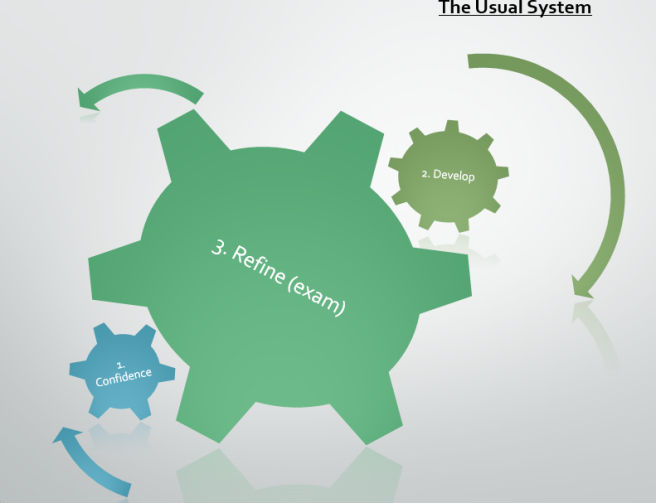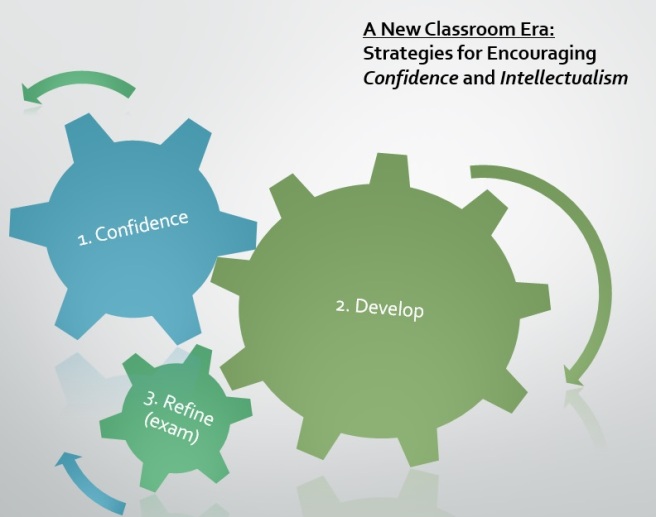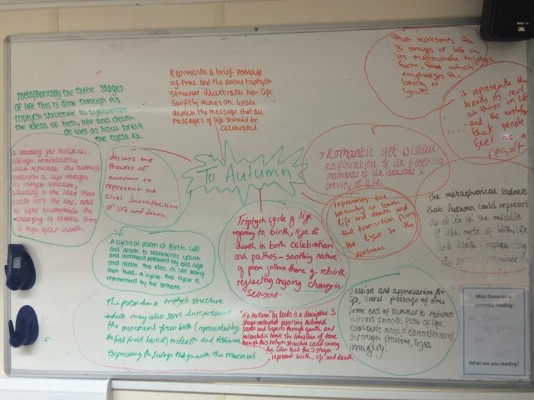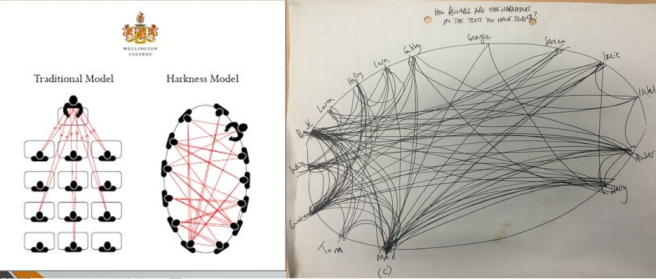There is no doubt that the teaching profession in the UK needs a new classroom era. When I first moved from Australia to begin teaching in England, I was astounded by the formulaic ‘exam-led teaching’ within the classroom. As a consequence of this, I was also astounded by the lack of confidence that pupils had – it was clear that most of them had been given knowledge rather than given the tools to form knowledge. An easy mistake, with significant consequences.
Not only does this style of teaching disempower a student’s ability to develop personal, intellectual and critical thinking skills, it means teachers are stressed; working overtime to ensure they have given everything – thus becoming disempowered and disengaged themselves (articles: here, here, here, here and here).
In fact, a brilliant article by David Western ‘How Do We release Greatness in Teachers’ reminds us that “working with students is a joy” but is unsustainable as “schools often compound the stress and exhaustion” onto their staff. And further to this, Carl Hendrick’s recent post ‘The Role of a Teacher Should be privileged over any Leadership Role,’ Hendrick puts forward the argument that “teachers are leaders” but “even the kids are leaders” because a great school system should work to impart the “wonder of knowledge” to their students. So, while we are leaders for encouraging our students to achieve their ‘target grade’ or ‘whatever-letter-they-want’, we should be leading them to the importance of being a seeker of knowledge; a lover of reading; an enthusiast for intellectualism; a confident and critical thinker. We should not be teaching to the exam but beyond it.

Pictured above is a diagrammatical representation of the system we have been used to. It is one whereby confidence (both from students and staff) is pushed aside in favour of refining exam skills; ensuring that students can accurately get the details and knowledge they need for the exam. In this system, key quotes are handed to students, essays have a template, topic sentences are written and students fill in the blanks. It’s no wonder that when these safety nets are taken away, students fall apart.
The New Classroom Era:
What I would like to see, is something closer to this:

In this system, learning is facilitated by the teacher in a way that students develop their confidence to make more assertions about the content they are learning. Most of the learning in the classroom is focused around embedding and developing the knowledge; encouraging students to debate; to put forward different critical perspectives; to consider different cultural perspectives; to read beyond the text; to apply it to real-world situations; to consider the social importance of content; to consider the political messages; to consider the philosophical or ethical challenges; to just immerse themselves in learning. Then, only then, should a small part be towards refining to the exam (which will come far more easily if you get number 2 right).
So, How?
From here, I’m going to talk through a range of strategies that have worked for me in both the state, academy and independent sectors of education that will hopefully give suggestions that can move your classroom into the second model of teaching. I have taught in a mostly EAL school, the state system (UK and Australia) and I have used these on a range of students. Almost without failure, they have successfully encouraged them to become critical thinkers who are not afraid to put forward their ideas, opinions or thoughts – doing so in a confident and intellectual way.
The New Classroom Era: 1. Confidence
As a teacher passionate about education, I strongly believe it is my job to build the confidence of my students. When I say confidence, however, I do not mean arrogance (one cannot be both intelligent and arrogant), it is rather about ensuring that my classroom environment is one that enables intellectualism to flourish and students do not fear ‘getting it wrong’ or ‘taking an educated risk’. Ultimately, my classroom is my space; each space is a microcosm; your classroom does not have to have the same belief systems as the corridor if you do not want it to. You can achieve this by:
- Asserting that your classroom space is ‘basically your room’ – You spent just as much time (if not more) there than your bedroom so you have a good foundation to have it the way you like. Therefore, I like it to be nerdy, thank you.
- Praising personalised responses – A* is personal. Give verbal praise for behaviours that you want to encourage. “Wow, a very thoughtful and unique perspective, thank you” or “Yes, I like that you thought differently about that but put it forward in an objective and intelligent way”. Even the students labelled to be ‘of lower ability’ will step up to this. They’re clever too.
- Give tasks that encourage personal responses – I always give students time to write an answer in their books before sharing it on my board. A start could be “What do you think ‘To Autumn’ is about?” Help them with a stem that is “To Autumn is about…” and then let them write their personal opinion. From there, you can discuss the strongest ideas (get them to evaluate and circle the ‘better ones’) but it means you’re not just always listening to the student who is willing to blurt out the answer and you’re empowering them all to realise that their ideas are valid and presentable.

The New Classroom Era: 2. Knowledge and Development
This is the fun bit – the reason we all went into education. Once you have built the strategies that encourage all students to understand their value in the classroom, lead them. You have to lead them 1) to knowledge, and then 2) to good, disputational and critical thinking. In my talk with Carl Hendrick at Swindon ResearchED, we emphasise that this ‘stage’ can only occur once students have a solid knowledge of information. Do not skip that step, it is key. Once you have that, spend most of your class time further empowering your students to love learning and think critically:
- Literary Fireworks – To get students thinking evaluative and personally about the controversial characters and topics in their exams, get them to debate them. You only need to give 2 adjectives to ‘fire’ at students. For example: Raleigh: Romantic or Repressed? Stanhope: Demanding or Depressed? This is enough to get them to consider different themes, plot and context while evaluating character effectively.
- Questions to Statements – Another way to do this effectively is to turn your questions into statements. Change the question ‘How is guilt shown in Claudius here?’ to ‘Claudius does not show guilt. Discuss’. Or, better still, have a statement from a literary critic that you could put up and get them to agree or disagree. Again, students will need to draw from a solid understanding of the text as well as the nuances of language to effectively debate this. Even your supposed ‘weaker’ students will get involved because they like challenges.
- Harkness – Harkness is a fantastic student-led method that moves this learning into an evolving discussion. Again, we all know the importance of setting up an environment to promote learning and with Harkness, it truly encourages discussion, debate and evaluation as it physically provides a platform to do this. Teacher input should be minimal; student output should be maximum. Also, it an effective way to evaluate whether students haven’t studied or do not know content – you cannot have a conversation without knowledge.

The New Classroom Era: 3. Refinement
So obviously we cannot steer away from the fact that students will have to refine their knowledge to ‘fit’ the exam but the teaching of this should be minimal because simply fitting a text into an exam box will not ignite a student’s love for learning. A few strategies I have implemented to ensure I teach to the exam without limiting pupils are the following:
- Use multiple choice as debate ‘refinement’ tools – Most of you by now are probably working to implement regular multiple choice exams into your lessons. Use these as tools to teach students that there is not only a right answer, but there is a ‘more right’ answer. This will encourage good debate but will steer students away from their bad habits as well. (The student below now knows I never want to see the word ‘creepy’ in his essays – ever).

- Avoid PEE – Seriously. Leave it at the door. Teach them content, not structure. We all know the best paragraphs are not simply PEE but PEEXEEEXXEXEXEEXEEEXP (X – unknown) so by teaching them PEE you are limiting them from ‘delving into’ the text to the level they might want. So just ensure them they have to 1) embed quotes, 2) developed and evaluative analysis, 3) sophisticated language and phrasing 4) effect etc – but these things are often best implemented when the pupil has creative control of structure.
We must not give up on having a new classroom era. It is possible to achieve an environment where students love learning – I am sure you have, or do see, this occur throughout your school at particular times. As educators, we must inspire and facilitate the learning of our students so that they are sent into the world as young people who are able to make change and take creative risks, not just as adolescent adults who are incompetent without ‘a structure,’ ‘a help sheet’ or a ‘prewritten topic sentence’. Wouldn’t that be nice?
I like this approach! I agree that students need to move beyond PEE – it’s like any teaching technique which provides an early scaffolding framework. If you leave it in place for too long it will constrict their development! I would argue, though, that the “x” in your alternative isn’t unknown – there are an array of techniques that can be used and taught to give students a selection to choose from in order to develop their analytical writing. Giving them this armoury will allow them to be more selective and critical in their work – but saying it’s “unknown” creates a mystique which can be off-putting. Nevertheless I get your direction of travel here – I am as frustrated as anyone by students arriving in Year 12 still restricted by the PEE formula! Thanks for the thought-provoking post.
LikeLike
Thank you very much! I’m glad it resonated with you and I definitely agree that you’re right about the X being able to be developed. Confidence and personal voice is usually the key. Strategies to assist this are always welcomed!
Best,
Sarah
LikeLiked by 1 person